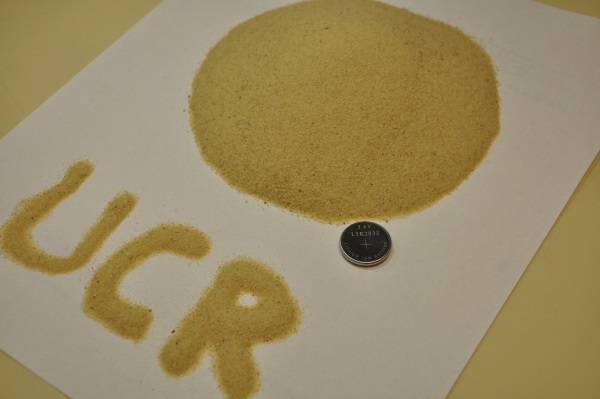If you’re on summer vacation, you may have sand on the brain. Well so do engineers.
Researchers from the University of California, Riverside’s Bourns College of Engineering have created a lithium-ion battery whose key material is sand. Yes, sand.
 Lithium-ion battery made of sand that outperforms the current standard by three times.
Lithium-ion battery made of sand that outperforms the current standard by three times.
Graduate student Zachary Favors worked with engineering professors Cengiz and Mihri Ozkan to come up with the idea. You’ll never guess where Favors dreamed up such a battery. He was relaxing on the beach after surfing when he picked up some sand, took a close look at it and saw it was made up primarily of quartz, or silicon dioxide.
“This is the holy grail – a low cost, non-toxic, environmentally friendly way to produce high performance lithium ion battery anodes,” said Favors.
Favors is trying to build better lithium-ion batteries for electronics and electric vehicles, so he’s been focusing his research on the anode, or negative side of the battery.
Currently anodes are composed of graphite but as electronic devices become more powerful, researchers have had to look for more powerful sources so they’ve been looking to silicon materials.
How he transformed sand into battery
After his day at the beach, Favors crushed some sand down to the nanometer scale and did some purifying to get the sand to a bright white color that was similar in many ways to powdered sugar.
He then ground salt and magnesium and heated the powder combination. What he found was that the salt acted as a heat absorber and the magnesium removed the oxygen from the quartz, which resulted in pure silicon.
 From left: (b) unpurified sand, (c) purified sand, and (d) vials of unpurified sand, purified sand, and nano-silicon
From left: (b) unpurified sand, (c) purified sand, and (d) vials of unpurified sand, purified sand, and nano-silicon
The pure nano-silicon material actually formed in a very porous 3D silicon sponge-like composition which research has shown to be the key to improving performance of batteries built with nano-silicon.
Future Impact
According to the team, this kind of battery could extend the lifespan of silicon-based electric vehicle batteries up to three times or more, which would help consumers since those kinds of replacement batteries cost thousands of dollars.
It could also impact personal electronics like cellphones and tablets by extending recharges. Maybe you could power-up every three days instead of every day.
The team is now trying to produce larger quantities of the nano-silicon beach sand. The would also like to expand battery size, moving from coin-size batteries to pouch-size batteries that are used in cell phones.
Advertisement
Learn more about Electronic Products Magazine





